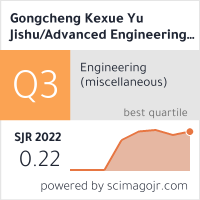Dear respected authors,
if you can't find our response then please search our mail in your spam box and communicate with us to the following mail as well: yutakaara27@gmail.com
Gongcheng Kexue Yu Jishu/Advanced Engineering Science
Gongcheng Kexue Yu Jishu/Advanced Engineering Science (ISSN: 2096-3246) is a bi-monthly peer-reviewed international Journal. Gongcheng Kexue Yu Jishu/Advanced Engineering Science was originally formed in 1969 and the journal came under scopus by 2017 to now. The journal is published by editorial department of Journal of Sichuan University. We publish every scope of engineering, Mathematics, physics.
Submission Deadline
(
Vol
56
, Issue
03
)
25 Apr 2024
Day
Hour
Min
Sec
Publish On
(
Vol
56
, Issue
03
)
30 Apr 2024
Aim and Scope
Gongcheng Kexue Yu Jishu/Advanced Engineering Science (ISSN: 20963246) is a peer-reviewed journal. The journal covers all sort of engineering topic as well as mathematics and physics. the journal's scopes are in the following fields but not limited to:
Agricultural science and engineering Section:
Electrical Engineering and Telecommunication Section:
Computer Science Section :
Civil and architectural engineering :
Mechanical and Materials Engineering :
kinematics and dynamics of rigid bodies, theory of machines and mechanisms, vibration and balancing of machine parts, stability of mechanical systems, mechanics of continuum, strength of materials, fatigue of materials, hydromechanics, aerodynamics, thermodynamics, heat transfer, thermo fluids, nanofluids, energy systems, renewable and alternative energy, engine, fuels, nanomaterial, material synthesis and characterization, principles of the micro-macro transition, elastic behavior, plastic behavior, high-temperature creep, fatigue, fracture, metals, polymers, ceramics, intermetallics.Chemical Engineering :
Food Engineering :
Physics Section:
Mathematics Section:
Latest Journals
Gongcheng Kexue Yu Jishu/Advanced Engineering Science
Full article
Gongcheng Kexue Yu Jishu/Advanced Engineering Science
Full article
Gongcheng Kexue Yu Jishu/Advanced Engineering Science
Full article
Gongcheng Kexue Yu Jishu/Advanced Engineering Science
In order to effectively solve the defects of boundary distortion, artifacts and training instability when repairing complex backgrounds and high-resolution images, an image repair algorithm based on dual generative adversarial networks and multi-scale discriminators is proposed. First, the image to be repaired is input into the content prediction network based on the dilated convolution layer, and the reconstruction loss and the global decision device based on the generative adversarial loss are used as the standard, and the rough repair is performed to obtain a clear and reasonable overall semantic consistency. structure. Then, the rough inpainting result is input into the detail inpainting network, and after being decoded and deconvoluted by the dilated convolution path and the perceptual convolution path, it is sent to three different-scale decision devices for optimization to improve the fine-grained texture of the inpainting result. Finally, 3 different scales of adversarial losses are used to optimize network parameters to capture multi-scale edge information of damaged regions and generate reasonable and realistic texture details. On the recognized image dataset, the algorithm of this paper is used for inpainting experiment, dual network inpainting comparison, high-resolution inpainting comparison, target removal experiment, ablation experiment and objective experiment. , can generate reasonable structure and clear texture details; the double network structure is better than the single network structure; the fine-grained texture obtained when repairing high-resolution images is better than the comparison algorithm; the algorithm proposed in this paper is used for high-resolution target removal , can get results with clear and reasonable structure and fine texture; ablation experiments verify the effectiveness of the proposed module; the peak signal-to-noise ratio, structural similarity, and average l1 error and average l2 The errors are all better than the compared classical inpainting algorithms. In short, the algorithm proposed in this paper can well combine the overall semantics of the image, enhance the restoration accuracy of image details, and effectively avoid problems such as structural texture disorder, pixel overlapping, and boundary distortion
.Full article
Gongcheng Kexue Yu Jishu/Advanced Engineering Science
Aiming at the problems of low brightness and blurred details in images captured under low light, an image enhancement algorithm based on gradient sparsity and multi-scale variational constraint was proposed by analyzing the defects of traditional Retinex theory. Firstly, the input image was transformed from RGB space to HSV space, and the luminance component was extracted to decouple three channels. Then, according to the gradient global significance of zero norm, a new relative total variation regular term was defined. After that, the luminance component was punished in HSV space, and a variational model with gradient sparsity was constructed to constrain the brightness channel. By expanding the control factors to multiple scales, a multi-scale variational constraint was formed, which improves the accuracy of illumination estimation and makes it more in line with the illumination distribution characteristics. According to the Retinex theory, areflection map corresponding to brightness channel was obtained. Then, the rough details, medium details and fine details of the image were extracted by using different illumination results corresponding to constraints in different scales of brightness channel, and the details of the reflection map was enhanced by multi-scale detail weighting. Finally, the illumination map after Gamma correction was recombined with the enhanced reflection ma, and the color space conversion was carried out to obtain the output enhanced image. Experimental comparisons show that the enhanced images of the proposed algorithm visually have richer colors richness and lower color difference level, and keep the naturalness well. Compared with the original images, the performance of mean value, average gradient and information entropy have been greatly improved. Compared with the existing advanced algorithms, the average quantitative index of the proposed algorithm achieves a better effect on the enhanced images of different types of low-light images with higher computational efficiency.
.Full article
